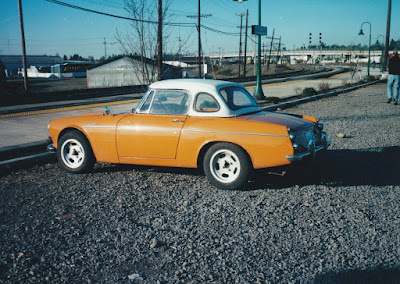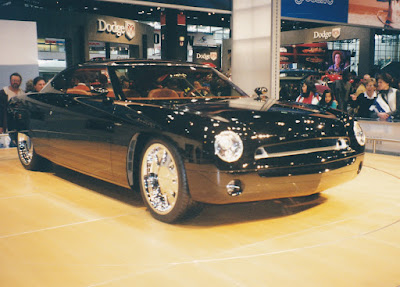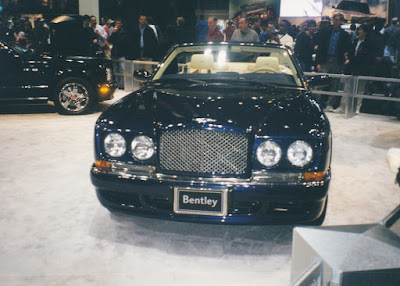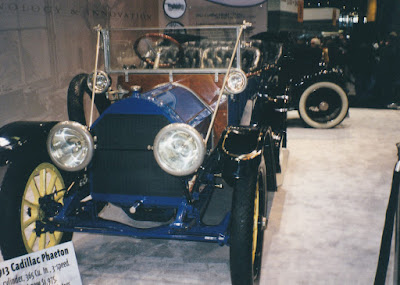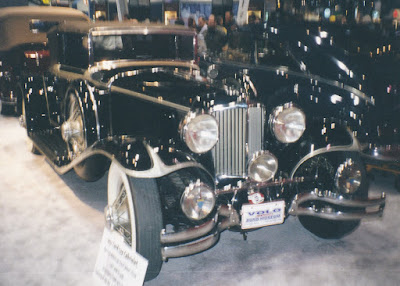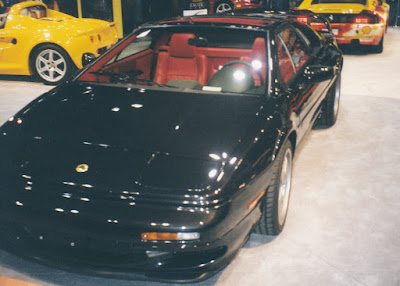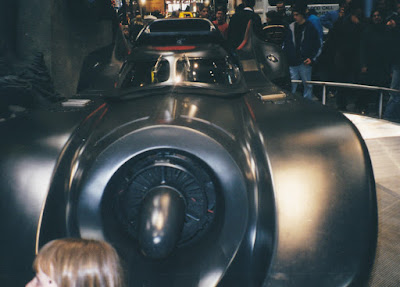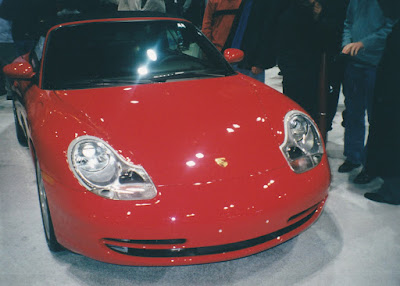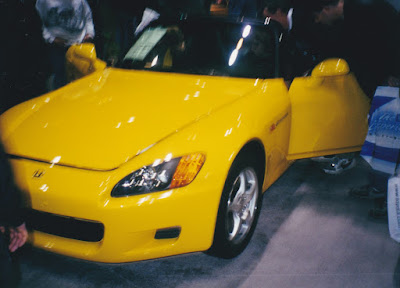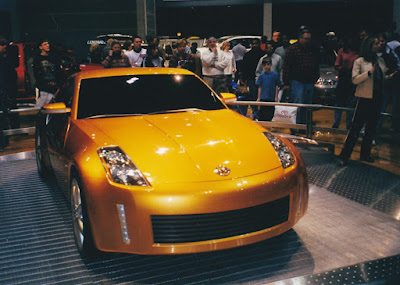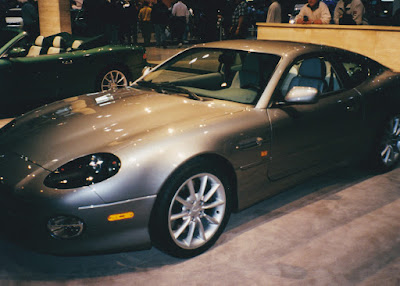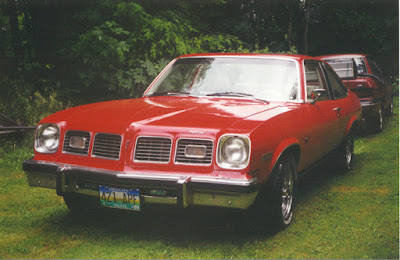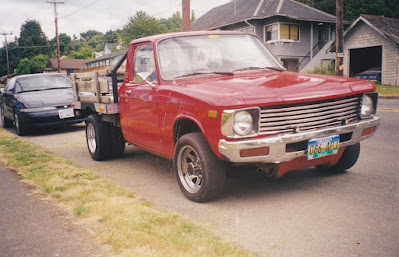Saturday, June 1, 2019
1966 Datsun 1600 Roadster
Datsun introduced its first sport roadster in 1959 with the Datsun 1000, and began importing them to the United States with the 1960 Datsun 1200. The Datsun 1500 was introduced in 1963, and in 1966 an increase in engine displacement also led to a name change and the model became the Datsun 1600. The Datsun 1600 was powered by a 96-horsepower dual-carburetor 1.6-liter overhead-valve inline 4-cylinder engine with a four-speed manual transmission.
All Datsun 1600s were sold as softtop roadsters. This well-kept and seemingly all-original example features an aftermarket removeable hardtop, turning this 1600 into an attractive two-toned coupe. I spotted it at the Amtrak depot in Vancouver, Washington, in February 2001.
Labels:
1966,
Convertible,
Datsun
2002 Lincoln Blackwood
The 2002 Lincoln Blackwood, shown here at the 2001 Chicago Auto Show, went on sale in the spring of 2001. Based on the rear-wheel drive Ford F-150 SuperCrew and powered by a 300-horsepower 5.4-liter 32-valve V8, with a maximum towing capacity of 8,700 pounds, the Blackwood was a limited-production “Luxury Utility Vehicle” with four full-size doors and a stylish carpet and stainless steel trimmed bed which Lincoln called a “Cargo Trunk,” which was capped by an electrically-operated rigid clamshell tonneau cover and featured integrated storage bins, flush-mounted tie-down hooks, a 12-volt power point and cool-to-the-touch LED lighting. On the outside, the “Cargo Trunk” featured imitation blackwood trim, and in place of a traditional truck tailgate, the Blackwood featured dual side-opening rear doors with integrated storage compartments. Additional standard featured included a power moonroof, Connolly leather seating surfaces, climate-controlled power front seats, wood- & leather-trimmed steering wheel with duplicate audio & climate controls, overhead console with On-Board Trip Computer displaying distance-to-empty, average fuel economy and digital compass and an Alpine® Audiophile Sound System with a 6-disc CD changer.
Labels:
2002,
Chicago 2001,
Lincoln,
Truck
2001 Mercury California Cougar Concept
The 2001 Mercury Cougar was powered by a 170-horsepower 2.5-liter DOHC 24-valve Duratec V6 engine and came standard with a AM/FM Stereo/single CD player, a 50/50 rear seatback, front independent MacPherson compact strut and Quadralink rear suspension systems, a SecuriLock™ passive anti-theft system, a trip computer and wraparound projector and reflector headlamps. Available options included leather seating surfaces, Anti-lock Brake System, aluminum footrest, clutch brake and accelerator pedal pads, and limited edition Cougar XR and Cougar C2 trims. This particular Mercury Cougar, shown here at the 2001 Chicago Auto Show, was a concept called the California Cougar, featuring a custom body kit by Wings West.
Labels:
2001,
Chicago 2001,
Concept,
Cougar,
Mercury
Ford F-150 Lightning Rod Concept
Ford first introduced the high-performance SVT Lightning version of the F-150 pickup in 1993 and produced it until 1995, then revived it in 1999 on the next generation of Ford F-150 with a 380-horsepower 5.4-liter V8 engine and a 4-speed automatic transmission. The Ford F-150 Lightning Rod Concept, shown here at the 2001 Chicago Auto Show, was based on that same generation of SVT Lightning, with smooth modified bodywork including a roof that was chopped by one inch, shorter overhangs, filled panels, and polished aluminum trim. Flame patterns based on Maori tattoos decorated the tonneau cover and dashboard, embossed into the headliner and leather-wrapped bucket seats, and carved into the treads of the 20-inch tires.
Labels:
Chicago 2001,
Concept,
Ford,
Truck
Ford Forty-Nine Concept
Influenced by the classic 1949-1951 Ford, the Forty-Nine coupe concept also had the chopped and channeled look on customized cars from that era. Displayed at the 2001 Chicago Auto Show the Forty-Nine featured rounded high intensity discharge and projector beam front lighting, sleek narrow wrap-around LED tail lights, and a roof with an all-glass upper structure. Inside, a raised console ran down the middle between the four bucket seats, and in front of the driver was a classic single-dial gauge cluster. A “Powered by Thunderbird” badge on the side announced that a Thunderbird 3.9-liter DOHC V8 in the engine bay was tuned to fit the car’s appearance and refined muscle.
Labels:
Chicago 2001,
Concept,
Ford
2001 Rolls-Royce Silver Seraph
The Rolls-Royce Silver Seraph, shown here at the 2001 Chicago Auto Show, was introduced in 1998 and was powered by a BMW-designed 322-horsepower single-overhead-cam 5.4-liter V12 engine. With a base curb weight of 5,075 pounds, the Silver Seraph could accelerate from 0 to 60 miles per hour in under 7 seconds.
Labels:
2001,
Chicago 2001,
Rolls-Royce
2001 Bentley Azure
The Bentley Azure, shown here at the 2001 Chicago Auto Show, was introduced in 1995 and was powered by a 385-horsepower overhead-valve 6.75-liter turbocharged V8 engine. With a base curb weight of 5,075 pounds, the Bentley Azure could accelerate from 0 to 60 miles per hour in 6.3 seconds and reach a top speed of 150 miles per hour.
Labels:
2001,
Bentley,
Chicago 2001,
Convertible
2001 Qvale Mangusta
The Qvale Mangusta, shown here at the 2001 Chicago Auto Show, is an Italian sports car that was developed jointly by Qvale and De Tomaso and was originally introduced in 2000 as the De Tomaso Mangusta, however De Tomaso and Qvale promptly parted ways, and the car was sold under the Qvale name. Powered by a 320-horsepower 4.6-liter Ford Modular Cobra SVT V8 engine with a 5-speed manual or 4-speed automatic transmission, the rear-wheel-drive Mangusta could accelerate from 0 to 60 miles per hour in 5.3 seconds and reach a top speed of 160 miles per hour with the manual transmission. The Mangusta featured plastic body panels and a unique convertible top called a “roto-top,” with a manually removable center section as with a targa top, with the rear section able to electrically rotate into a cavity behind the rear seats to make the car a full convertible. This example is painted pearlescent Corallo Red with a Cappuccino interior.
Labels:
2001,
Chicago 2001,
Convertible,
Qvale
1956 GMC Suburban Town & Country Pickup
Introduced in 1955, the Suburban Town & Country was GMC’s version of Chevrolet’s Cameo pickup. Like the Cameo, the Suburban Town & Country featured a more luxurious interior and fiberglass rear fender covers to create the first smooth-side box. This 1956 model, one of only about 200 built that year, is powered by an optional 155-horsepower 317-cubic-inch Pontiac V8 engine with a 2-barrel carburetor and a 7.4 to 1 compression ratio. Other options include a Hydramatic automatic transmission, two-tone cab, large rear window, tinted glass and whitewall tires. It was displayed at the 2001 Chicago Auto Show by the Volo Auto Museum.
Labels:
1956,
Chicago 2001,
GMC,
Truck,
Volo
1913 Cadillac Phaeton
This 1913 Cadillac Phaeton was based on the Cadillac Model G that was introduced in 1909. It is powered by a 365-cubic-inch L-head inline 4-cylinder engine with a 3-speed manual transmission, with increased stroke and displacement over the previous year’s model. 1913 was also only the second year for Cadillac’s electric starter. This design would continued essentially unchanged through 1914. The 1915 Cadillac Model 51 would introduce Cadillac’s first V8 engine. This example was displayed at the 2001 Chicago Auto Show by the Volo Auto Museum.
Labels:
1913,
Cadillac,
Convertible,
Volo
1949 Buick Super Estate Wagon
The Buick Super was redesigned for 1949, sharing a body with the also-new Roadmaster, which was 5-inches longer. The Buick Super Estate Wagon was powered by a 115-horsepower 248-cubic-inch Fireball inline 8-cylinder engine, with the optional Dynaflow automatic transmission bringing an increase to 120 horsepower. Station wagons at the time featured extensive wood trim, and the Buick Super Estate Wagon is no exception, featuring seasoned maple and northern elm on the exterior, though the structure was now largely steel, with all-steel center pillars, steel doors, and a full-length solid steel Turret Top. The interior featured fine-grained Mahogany-veneer wood paneling, carpeted floors, and a rear seat that folds flat and was displayed at the 2001 Chicago Auto Show by the Volo Auto Museum.
Labels:
1949,
Buick,
Chicago 2001,
Estate Wagon,
Volo
1931 Cord L-29 Cabriolet
The Cord L-29 was introduced in 1929 and was the first American front-wheel-drive car to be offered to the public. Powered by a 115-horsepower 299-cubic-inch Lycoming L-head inline 8-cylinder engine with a 3-speed manual transmission, the Cord L-29 could accelerate from 0 to 60 miles per hour in 24 seconds and reach a top speed of 78 miles per hour. Front-wheel drive gave the Cord L-29 a number of advantages. The lack of a central driveshaft or a live rear axle allowed it to have a lower ride height than any comparable luxury car, and mounting the transmission and front differential ahead of the engine resulted in nearly perfect weight distribution. Other unique features of the Cord L-29 included a dashboard-mounted shifter, inboard front brakes, and a Bijur chassis lubrication system that feeds oil to the water pump, fan, brake pedal linkage, clutch release bearing and rear springs from a central reservoir at the press of a pedal. Unfortunately, the L-29 was released shortly before the stock market crash of 1929, which would have a dramatic effect on luxury car sales. This 1931 Cabriolet represents the final year of production for the Cord L-29 and was displayed at the 2001 Chicago Auto Show by the Volo Auto Museum.
Labels:
1931,
Chicago 2001,
Convertible,
Cord,
Volo
2001 Lotus Esprit V8
The Lotus Esprit was first introduced in 1976, with a fiberglass body and a 2.0-liter inline 4-cylinder engine, and was restyled in 1987. The Lotus Esprit saw few external changes from year to year; one major internal change was the introduction of the V8 engine in 1996. Displayed at the 2001 Chicago Auto Show, this 2001 Lotus Esprit V8, with its 350-horsepower mid-mounted dual overhead cam twin-turbocharged 3.5-liter V8 engine, will accelerate from 0 to 60 miles per hour in 4.4 seconds and reach a top speed of nearly 180 miles per hour. The Lotus Esprit would continue in production until 2004 for a total of 28 years.
Labels:
2001,
Chicago 2001,
Lotus
2000 Lamborghini Diablo VT 6.0
The Lamborghini Diablo was introduced in 1990, originally powered by a longitudinally-mounted 485-horsepower 5.7-liter dual-overhead-cam 48-valve V-12 engine with 428 foot-pounds of torque. The original Lamborghini Diablo could accelerate from 0 to 60 miles per hour in 4.7 seconds and reach a top speed of 205 miles per hour. The all-wheel-drive Diablo VT first appeared in 1993, featuring a carbon-fiber driveshaft and a viscous center differential. The traction-enhancing all-wheel drive system of the Diablo VT could direct up to 25% of the power to the front wheels if the rear wheels started spinning faster than the front wheels. The Diablo received a facelift in 1999, with the most obvious change being the replacement of the original pop-up headlights with fixed composite headlights and an increase in power to 529 horsepower. Following Lamborghini’s 1998 sale to Audi, the Diablo VT 6.0 was introduced in 2000, featuring the 575-horsepower 6.0-liter dual-overhead-cam 48-valve V12 engine with 457 foot-pounds of torque from the limited production Diablo GT, along with the increased use of carbon-fiber in the bodywork and the interior. Displayed at the 2001 Chicago Auto Show, the Diablo VT 6.0 could now accelerate from 0 to 60 miles per hour in 3.6 seconds, with a price starting at $230,000. The Lamborghini Diablo’s last year would be 2001, when it would be replaced by the new Murciélago.
Labels:
2000,
Chicago 2001,
Lamborghini
2001 Avanti
The Studebaker Avanti was introduced in 1963. Failing Studebaker discontinued it in 1964, but sold the rights to the design to the new Avanti Motor Corporation, which revived the sports car in 1965 as the Avanti II. The company maintained limited but profitable production into the 1980s. A new generation of Avanti was introduced, and the original Studebaker chassis was eventually abandoned for a newer, more modern Chevrolet chassis. Production continued until 1991, when the company went bankrupt. In the late 1990s, a new Avanti design based on the chassis of the Chevrolet Camaro and Pontiac Firebird was developed, and this new design was introduced to the public in 2001.
This was an entirely new design, with little in common with the previous Avanti except the basic styling. Shown here at the 2001 Chicago Auto Show, the new Avanti was available as either a T-Top Coupe or as a Convertible. With General Motors discontinuing the Camaro and the Firebird after 2002, few of this generation of Avanti were ultimately built, and a new design based on the Ford Mustang was introduced in 2004.
Labels:
2001,
Chicago 2001,
Convertible,
Studebaker
1989 Batmobile
This example of the Batmobile as it appeared in the motion pictures Batman from 1989 and Batman Returns from 1992 is almost certainly a replica. At the time, General Motors was licensing Batman and the Batmobile to promote its OnStar service in a series of television commercials, and this appearance at the 2001 Chicago Auto Show was part of that promotion.
Labels:
1989,
Chicago 2001
2001 Porsche 911 Carrera Convertible
This generation of the Porsche 911 was introduced in 1998 as the first completely-redesigned 911 since the original debuted in 1963. The 2001 Porsche 911 Carrera, shown here at the 2001 Chicago Auto Show, was essentially unchanged, aside from a slight increase from 296 horsepower to 300 horsepower for its rear-mounted water-cooled 3.4-liter dual-overhead-cam horizontally-opposed "flat" 6-cylinder "boxer" engine. The Porsche 911 Carrera was available with either a six-speed manual or a 5-speed Tiptronic automatic transmission and either rear-wheel or all-wheel drive. 2001 was the last year for this generation’s original styling; in 2002 the 911 Carrera would receive the same headlights as the Porsche 911 Turbo.
Labels:
2001,
911,
Chicago 2001,
Convertible,
Porsche
2001 Porsche 911 Turbo
The 2001 Porsche 911 Turbo, shown here at the 2001 Chicago Auto Show, was released in the United States in the Summer of 2000. Powered by a 420-horsepower 3.6-liter dual-overhead-cam, twin-turbocharged horizontally-opposed "flat" 6-cylinder "boxer" engine with 413 foot-pounds of torque at 2,700 rpm, with either a six-speed manual or a 5-speed Tiptronic automatic transmission, the all-wheel drive 911 Turbo could accelerate from 0 to 60 miles per hour in about 3.5 seconds and reach a top speed of 190 miles per hour.
Labels:
2001,
911,
Chicago 2001,
Porsche
Bobby Labonte NASCAR Pontiac Grand Prix
Bobby Labonte was the winner of the 2000 Winston Cup championship, driving the #18 Interstate Batteries Pontiac Grand Prix, shown here at the 2001 Chicago Auto Show. Labonte switched from Chevrolet to Pontiac in 1997, and would switch back to Chevrolet in 2003, which would be Pontiac’s last year with NASCAR.
Labels:
Chicago 2001,
Pontiac
2000 Cadillac Northstar LMP
Cadillac built the LMP (LeMans Prototype) in 2000 to communicate a new world image and to challenge European luxury brand racing cars. Under Cadillac’s supervision, domestic builder Riley & Scott constructed the LMP with a carbon fiber monocoque design. A 650-horsepower twin-turbocharged Northstar 4.0-liter V8 engine powered the vehicle, and a functional Cadillac-type grille was built into the aerodynamic front section. Seven LMP monocoques were built in 2000, with five used in competition, this example used as a show car, as seen here at the 2001 Chicago Auto Show, and one spare.
Labels:
2000,
Cadillac,
Chicago 2001
2001 Honda S2000
The Honda S2000, shown here at the 2001 Chicago Auto Show, was introduced in 1999 for the 2000 model year. The Spa Yellow color was new for 2001. The S2000’s 240-horsepower 2.0-liter 16-valve dual overhead cam VTEC inline 4-cylinder engine produced more power per liter than any naturally-aspirated production engine in the world. With a standard 6-speed manual transmission, the rear-wheel drive S2000 could accelerate from 0 to 60 miles per hour and 5.8 seconds with a quarter-mile time of 14.7 seconds at 95 miles per hour. Featuring optimum 50/50 front-to-rear weight distribution, rigid body construction, and double-wishbone front and rear suspension, the S2000 could achieve 70 mile per hour slalom speeds. Standard features included a torque-sensing limited-slip differential, 4-channel anti-lock braking system, 16-inch alloy wheels, high-intensity discharge headlights, electrically-powered soft top, power windows, mirrors, and door locks, cruise control, AM/FM Stereo CD Player, digital instrument panel, engine start button, leather-wrapped steering wheel, leather-trimmed seats & door panels, dual front airbags, Immobilizer Theft-Deterrent System and Remote Entry System.
Labels:
2001,
Chicago 2001,
Convertible,
Honda
2001 Acura NSX
The mid-engined 2001 Acura NSX, shown here at the 2001 Chicago Auto Show, with its all-aluminum architecture was powered by a 290-horsepower 3.2-liter dual overhead cam V6 with a 6-speed manual transmission or a 252-horsepower 3.0-liter dual overhead cam V6 with a fingertip-controlled SportShift automatic transmission. Four-wheel anti-lock disc brakes were standard. 2001 would be the last year for the NSX’s original body before receiving a facelift for 2002.
Labels:
2001,
Acura,
Chicago 2001
Nissan Z Concept
The Nissan Z Concept from 2001, shown here at the 2001 Chicago Auto Show, was described in the Nissan brochure as “…revolutionary, inside and out. Innovative, yet with a nod to heritage.” Scheduled for release in the summer of 2002, it would become the 2003 Nissan 350Z, built in Oppama, Japan, with few changes, featuring a 3.5-leter aluminum-alloy 24-valve dual overhead cam V6 engine with molybdenum-coated pistons and a close-ratio six-speed manual or five-speed automatic transmission. Other significant standard features included a 160-watt 6-speaker AM/FM/CD audio system, 4-wheel anti-lock disc brakes, and 17-inch 7-spoke aluminum-alloy wheels (as opposed to the 20-inch 7-spoke flangeless rims on the coppertone-painted Z concept). In addition to the base model, the 350Z would be available in Enthusiast, Touring, Performance, and Track models as well.
Labels:
Chicago 2001,
Concept,
Nissan
2001 Aston Martin DB7 V12 Vantage
The Aston Martin DB7 V12 Vantage, shown here at the 2001 Chicago Auto Show, was introduced in 2000, with a 420-horsepower 6.0-liter dual overhead cam V12 replacing the previous 335-horsepower 35-liter supercharged inline six-cylinder engine of the standard DB7, increasing top speed from 163 miles per hour to 185 miles per hour. With the manual transmission, the Vantage could accelerate from 0 to 60 miles per hour in 5.0 seconds; an automatic transmission was also available. The DB7 V12 Vantage was available as a coupe or a convertible, with features including Brembo brakes, 18-inch alloy wheels, and 4-wheel disc anti-lock brakes.
Labels:
2001,
Aston Martin,
Chicago 2001
Volvo Safety Concept Car
The Volvo Safety Concept Car (SCC), shown here at the 2001 Chicago Auto Show, featured innovative passive safety ideas. The driver could see through the A-posts, which used see-through Plexiglass in a steel box construction, and the B-posts curved inwards at the top for unobstructed field of vision to the offset rear. Embedded in the door mirrors and rear bumper were sensors that alerted the driver of approaching traffic in the “blind spot” to the offset rear.
Labels:
Chicago 2001,
Concept,
Volvo
Hyundai HCD6 Roadster Concept
The Hyundai HCD6 Roadster Concept, shown here at the 2001 Chicago Auto Show, was a prototype for a mid-engine two-seat roadster powered by a high-performance version of the 2.7-liter dual overhead cam V6 engine from the Hyundai Santa Fe SUV, with a six-speed manual transmission. The HCD6 featured an aggressive nose, floating carbon fiber bumpers, projector beam lights that turn with the front wheels, and a deeply sculpted side air intake flowing into the rear wheel wells.
Labels:
Chicago 2001,
Concept,
Convertible,
Hyundai
2002 Ford Thunderbird
The new Ford Thunderbird, shown here at the 2001 Chicago Auto Show, was introduced in 2001 as a 2002 model, with retro styling like roof portholes, front-fender grilles and afterburner taillights to recall the Thunderbirds of the 1950s and 1960s. Based on the same chassis as the Lincoln LS and the Jaguar S-Type, the new Thunderbird was powered by a 3.9-liter, 32-valve aluminum dual overhead cam V8 engine that produced 252 horsepower at 6,100 rpm and 261 foot-pounds of torque at 4,300 rpm. With a 5-speed automotive transmission with overdrive, it could accelerate from 0 to 60 miles per hour in approximately 6.8 seconds. The Thunderbird was offered with five exterior colors: Whisper White, Midnight Black, Thunderbird Blue, Torch Red and Inspiration Yellow. Standard features include a power retractable convertible top, power 4-wheel ventilated 4-channel anti-lock disc brakes, dual exhaust, 17-inch painted aluminum wheels, dual power mirrors, power windows, and door locks, Securilock™ passive anti-theft system, perimeter alarm, remote keyless entry, leather-wrapped steering wheel with audio and speed control and power tilt/telescoping steering column, speed-sensitive variable intermittent wipers, automatic headlights with on/off delay, illuminated entry with theater dimming feature, NUDO® leather-trimmed seats with recliners, power 6-way driver’s seat & 2-way passenger seat, front and side-impact airbags for driver and passenger, air conditioning with dual automatic temperature control, AM/FM stereo with in-dash 6-disc CD changer, clock and Audiophile sound system, and brushed aluminum interior highlights. Available options include supplemental parking lamps, 17-inch chrome wheels, all-speed traction control, interior color accent packages, and a removable hardtop with a heated glass rear window, storage cart, and cover.
Labels:
2002,
Chicago 2001,
Convertible,
Ford,
Thunderbird
Monday, January 14, 2019
1940 Packard One-Ten Club Coupe
Responding to the Great Depression, luxury automaker Packard introduced a line of cars powered by six-cylinder engines in 1937, alongside its eight-cylinder powered standard One-Twenty line. Initially called simply the Packard Six, the smaller Packard line was renamed Packard One-Ten in 1940. The Packard One-Ten series had a 122-inch wheelbase, as opposed to the Packard One-Twenty line's 127-inch wheelbase, and was powered by a 245-cubic-inch six-cylinder version of Packard's L-head in-line engine that was rated at 100-horsepower, not much less than the One-Twenty's 120-horsepower 282-cubic-inch eight-cylinder engine. Packard built 62,300 One-Tens and 28,138 One-Twenties for 1940. The One-Ten line was expanded in 1941, but in 1942 the Packard One-Ten went back to being the Packard Six before World War II halted civilian Packard production. This 1940 Packard One-Ten Club Coupe was photographed in the Days in the Park parade in Rainier, Oregon, on July 8, 2000.
Labels:
1940,
Packard,
Rainier 2000
1975 Pontiac Ventura
Pontiac first introduced the Ventura name in 1960 as a higher-priced full-size model, and throughout the 1960s it alternated between being a model and being a trim level for the Pontiac Catalina. In 1971, Pontiac applied the Ventura name to its new rebadged version of the compact Chevrolet Nova. The Nova and its copies (the Pontiac Ventura, the Oldsmobile Omega, and the Buick Skylark & Apollo) were restyled for 1975, as illustrated by this example.
The Pontiac Ventura was marketed as a more luxurious sports car than the Chevrolet Nova. (Note that this example has an aftermarket steering wheel, but the rest of the interior is largely stock.)
The Pontiac Ventura was offered as a two-door coupe, a two-door hatchback, or a 4-door sedan. This is the hatchback version. By 1975, the Ventura was not available with a Pontiac engine, instead being offered with a variety of Chevrolet and Buick engines, with the Buick 350-cubic-inch V8 being the most powerful option.
The Ventura name would not last much longer. In the middle of 1977, Pontiac introduced another version of the Nova, the more luxurious Phoenix, which replaced the Ventura entirely for 1978.
Chevrolet LUV
The Chevrolet LUV pickup was a rebranded Isuzu that was introduced in America in 1972 to compete with the compact pickups by Datsun and Toyota, as well as the Ford Courier, which was a rebadged Mazda. The LUV was powered by a 1.8-liter 4-cylinder engine, rated at 75 horsepower through 1976, then rising to 80 horsepower in 1977. Originally featuring quad headlights, the LUV was restyled in 1978 as shown here, and four-wheel drive was introduced in 1979. A second-generation was introduced in 1980 alongside its Isuzu counterpart, which made its American debut in 1981. The LUV was replaced in America by the domestic-built Chevrolet S-10 in 1982, but the LUV continued in South America with the name being passed on to subsequent Isuzu designs into the 21st century. The example pictured here features aftermarket modifications including a rear axle with dual wheels and a flatbed.
Sunday, January 13, 2019
2000 Porsche 911 Carrera
This generation of the Porsche 911 was introduced in 1998 as the first completely-redesigned 911 since the original debuted in 1963. The 2000 Porsche 911 Carrera was essentially unchanged, powered by a rear-mounted water-cooled 296-horsepower 3.4-liter dual-overhead-cam horizontally-opposed "flat" 6-cylinder "boxer" engine, with either a six-speed manual or a 5-speed Tiptronic automatic transmission and either rear-wheel or all-wheel drive. The Porsche 911 Carrera could accelerate from 0 to 60 miles per hour in under 5 seconds and reach a top speed of 178 miles per hour, with a price starting at $68,000. Though this picture doesn't illustrate it well, this example, photographed at the 2000 Portland International Auto Show at the Oregon Convention Center in Portland, Oregon, featured metallic color-shifting paint that changed from dark green to purple depending on how the light hit it.
Panoz AIV Roadster
The Panoz Roadster was originally introduced in 1992 featuring aluminum body panels on a steel frame and powered by the Ford 5.0-liter V8 engine from the Ford Mustang. Only 44 Panoz Roadsters were built to the original design through 1995. In 1996, a new version was unveiled with the same aluminum body panels bonded to an aluminum space frame using special adhesives, and the new 4.6-liter 32-valve double-overhead-cam all-aluminum V8 engine and 5-speed manual transmission from the Ford Mustang SVT. This design was approximately 70% aluminum, and was called the Panoz AIV Roadster. The letters "AIV" stand for "Aluminum Intensive Vehicle." The extensive use of aluminum reduced the roadster's weight to 2,570 pounds, and combined with the new engine's 305 horsepower and 300 foot-pounds of torque, gave the AIV Roadster impressive performance, capable of accelerating from 0 to 60 miles per hour in 4.3 seconds and reach a top speed of 140 miles per hour, while also delivering fuel economy of 19.9 miles per gallon. A total of 176 Panoz AIV Roadsters were produced through 1999, though some were not sold until 2000. This example was photographed at the 2000 Portland International Auto Show at the Oregon Convention Center in Portland, Oregon.
Ferrari 360 Modena
The Ferrari 360 Modena was introduced in 1999 as a replacement for the Ferrari F355 Berlinetta after four years of development. Powered by the same 3.5-liter double-overhead-cam V8 as the F355, the 360 Modena featured a new intake track and a revised stainless-steel exhaust that increased the horsepower from the F355's 375 horsepower to 400 horsepower. The 360 Modena also featured reduced weight, increased performance, better handling, more structural rigidity, and increased interior room and comfort. Available with either a 6-speed manual transmission or an F1-style paddle shifter, the 360 Modena could accelerate from 0 to 60 miles per hour in 4.5 seconds. The Ferrari 360 Modena was priced between $135,000 and $144,000. This example was photographed at the 2000 Portland International Auto Show at the Oregon Convention Center in Portland, Oregon.
1991 Ferrari F40
This 1991 Ferrari F40 was displayed at the 2000 Portland International Auto Show at the Oregon Convention Center in Portland, Oregon. Enzo Ferrari was 89 years old when he unveiled the F40 in Maranello, Italy, on July 21, 1987. Hand-made in Italy with carbon-fiber body panels bonded to a space frame of steel tubing, the F40 has a curb weight of just 2,756 pounds. To keep the weight down, the F40 features a plastic windshield and manual plastic windows, a carbon fiber dashboard, analog gauges, and lacked interior door panels and door handles and features like a radio or power-assisted brakes, though it did have primitive air conditioning. Powered by a 2,936-cubic-centimeter, twin-turbocharged, intercooled V8 engine that produced 471 horsepower at 7,000 rpm and 426 foot-pounds of torque at 4,000 rpm with a 5-speed manual transmission, the F40 could accelerate from 0 to 60 miles per hour in 3.5 seconds, reach 125 miles per hour in 12.4 seconds, and eventually hit a top speed of 203.4 miles per hour. A total of 1,311 F40s were produced from 1987 to 1992. This car was priced at $299,000.
Subscribe to:
Posts (Atom)






